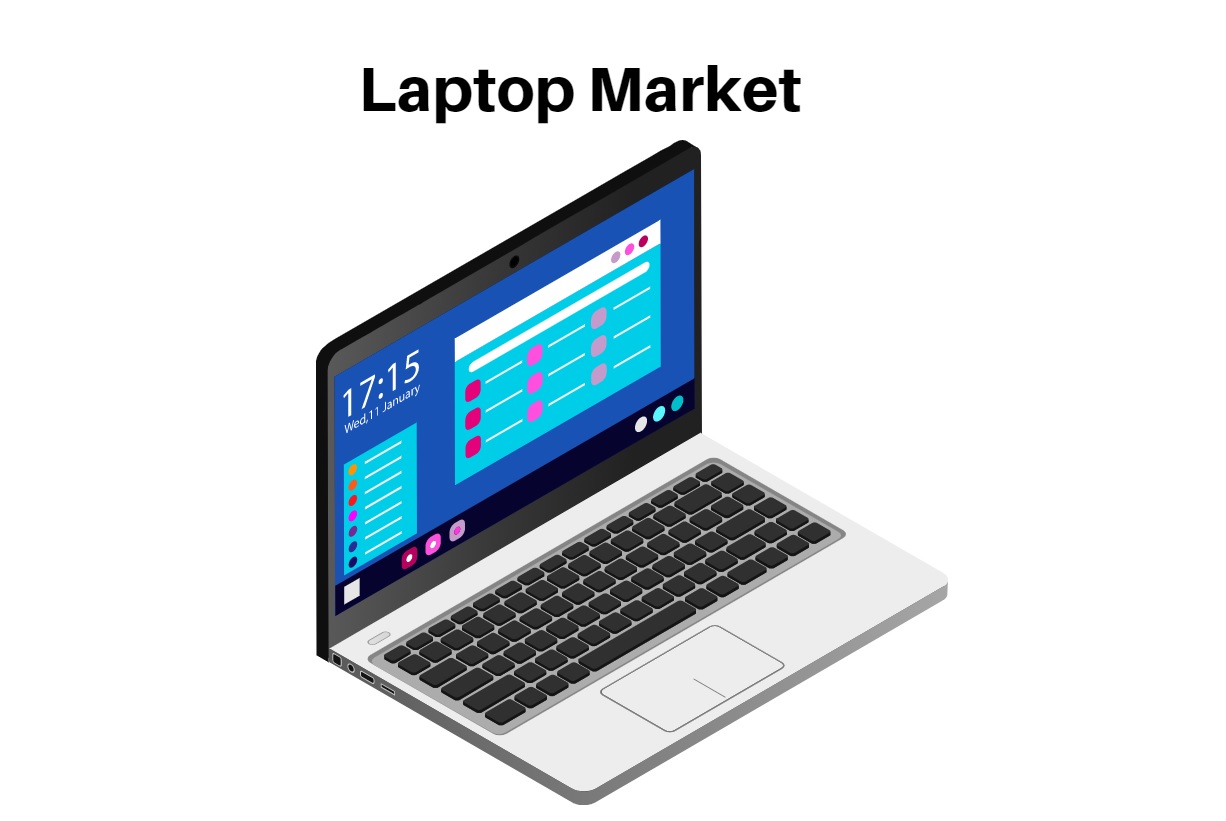Laptop Market Size Is Set To Expand With CAGR Of 2.30% By 2032

Page Contents
Market Overview
The Global Laptop Market size is expected to be worth around USD 209.11 billion by 2032 from USD 166.58 billion in 2022, growing at a CAGR(compound annual growth rate) of 2.30% during the forecast period from 2022 to 2032.
The laptop market is a fiercely competitive and rapidly-evolving sector that features various brands, models, and price points. People use laptops for both personal and professional activities such as remote work, online learning, gaming, entertainment, etc. The market is dominated by a few major players such as HP, Lenovo, Dell, Apple, and Asus each brand offers various models tailored towards different market segments. Additionally, smaller players exist that provide niche models with specific features.
Microsoft Windows remains the dominant operating system on the market, used by 99% of laptop users worldwide. Apple's macOS and Google's Chrome OS are popular alternatives in certain educational and creative sectors as well. In recent years, the laptop market has undergone dramatic transformations. There is now a greater focus on portability, performance, and sustainability. Furthermore, hybrid and convertible laptops – which can function both as traditional laptops and tablets have become more commonplace.
The COVID-19 pandemic has had a major effect on the laptop market, as more and more people are working from home and learning from their laptops. This trend is expected to persist even after the crisis ends as many organizations transition towards hybrid work models that require employees to telecommute at least part of the time.
Overall, the laptop market is expected to remain a vibrant and rapidly developing industry due to technological advancements and evolving consumer needs and preferences.
Request For Sample Report Here: https://market.us/report/laptop-market/request-sample/

Key Takeaways
- The global laptop market is fiercely competitive and rapidly evolving, featuring major players like HP, Lenovo, Dell, Apple, and Asus.
- Laptops are increasingly being utilized for both personal and professional tasks, such as remote work, online learning, gaming, and entertainment.
- The market is expected to expand at a steady rate between 2022 and 2032, with an anticipated compound annual growth rate (CAGR) of 2.30%.
- In the laptop market, there is an increasing emphasis on portability, performance, and sustainability.
- Hybrid and convertible laptops, which can double as both laptops and tablets, have become increasingly popular due to their versatility and adaptability.
- The COVID-19 pandemic has had a profound effect on the laptop market, with an increasing number of individuals working and learning from home.
- The market is predicted to remain a vibrant and rapidly developing industry, driven by technological advancements and shifting consumer needs and preferences.
Regional Analysis
- North America is a major market for laptops, with the United States leading the region's sales. Major players such as HP, Dell, and Apple dominate this space with an increasing demand for gaming and high-performance laptops.
- Europe is a major market for laptops, with countries like Germany, the United Kingdom, and France leading the charge. The region is marked by an intense demand for lightweight yet portable laptops that can be used both at work and during travel.
- Asia-Pacific is the fastest-growing region in the laptop market, driven by increasing demand from emerging economies such as China and India. The region is characterized by an increasing preference for affordable entry-level laptops as well as high-performance gaming laptops.
- Latin America's laptop market is small but growing, with countries like Brazil, Mexico, and Argentina leading the charge. The region is marked by an uptick in laptop demand from educational institutions as well as an increasing preference for gaming laptops.
- The Middle East and Africa region is a relatively small market for laptops, but it is growing rapidly due to increasing digitalization and the adoption of remote work and learning practices. There is an increasing demand for budget-friendly entry-level laptops as well as increased interest in gaming laptops.
- Overall, the laptop market is a global industry that is expanding rapidly across various regions worldwide due to increasing demand for remote work and learning, technological advances, as well as shifting consumer needs and preferences.
Purchase This Report At Discounted Rate Here: https://market.us/purchase-report/?report_id=52919
Drivers
Remote Work and Learning The COVID-19 pandemic has hastened the trend toward remote work and learning, leading to an uptick in laptop sales. This trend is expected to persist even after the crisis ends, as many organizations will likely adopt hybrid work models that require employees to work from home at least part of the time. Technological Advancements The laptop market is being driven by continuous technological improvements, such as faster processors, higher-resolution displays, and longer battery life. As new technologies like 5G wireless connection and foldable displays become available, demand for laptops is expected to increase.
Gaming The gaming industry is a major driving force in the laptop market, with an increasing need for high-performance laptops that can handle demanding games and software. Esports and online gaming have further fuelled this growth trend in gaming laptop sales. Portability Laptops are lightweight and highly portable, making them perfect for work and travel. As consumers look for more flexible and mobile computing solutions, demand for lightweight and portable laptops is expected to grow.
Education Laptops are increasingly commonplace in the educational sector, as many schools and universities adopt digital learning tools and online courses. As this sector continues to develop, so too will the demand for laptops. Sustainability The laptop market is increasingly focused on sustainability, with consumers and organizations seeking more eco-friendly products. This has resulted in the development of laptops made from recycled materials as well as energy-saving components and extended battery life.
Overall, the laptop market is driven by a combination of factors including technological advancements, shifting consumer needs and preferences, as well as industry trends such as remote work, gaming, and sustainability.
Restraints
Competition The laptop market is highly competitive, with many major players vying for market share. This intense competition can lead to price wars and reduced profit margins for laptop manufacturers. Saturation The laptop market is a mature market that has reached a level of saturation in some regions. As a result, laptop manufacturers may struggle to find new customers or grow their market share. Economic downturns can have a significant impact on the laptop market, as consumers and organizations may reduce their spending on non-essential items such as laptops.
Changing technology trends Rapidly changing technology trends can make laptops obsolete quickly. Consumers may be hesitant to purchase a new laptop if they feel that it will become outdated in a short amount of time. Security concerns Security is a growing concern for laptop users, with the risk of data breaches and cyber-attacks becoming more prevalent. This can lead to a lack of trust in laptops and a reduced demand for them. Environmental concerns The production and disposal of laptops can have a negative impact on the environment, leading to concerns about sustainability and the need for more environmentally friendly products.
Overall, the laptop market is subject to a range of restraints, including competition, economic downturns, changing technology trends, security concerns, and environmental concerns. Manufacturers must address these restraints to remain competitive and meet the evolving needs of their customers.
Opportunities
Emerging markets such as India, China, and Southeast Asia provide significant growth prospects for laptop manufacturers. These regions boast large populations with rising disposable income levels that make them attractive targets for laptop sales. Hybrid Work Models As more companies adopt hybrid work models, which combine remote work and in-office activities, laptop manufacturers are presented with an opportunity to design products that cater to this new trend. This could include laptops with improved video conferencing capabilities as well as longer battery life. Education Sector The education sector is a major market for laptops, with many schools and universities adopting digital learning tools and online courses. As this space continues to develop, there is an expanding opportunity for laptop manufacturers to design products specifically for this market.
Gaming The gaming industry is a major driver of the laptop market, with an increasing need for high-performance laptops that can handle demanding games and software. Manufacturers can capitalize on this trend by designing gaming-specific laptops featuring powerful graphics cards and sharp displays. Sustainability There is an increasing focus on sustainability in the laptop market, as consumers and organizations seek more eco-friendly items. This presents manufacturers with an opportunity to design laptops made from recycled materials as well as those featuring energy-saving components and longer battery lives. Innovation Innovation is essential to stay ahead in the laptop market. Manufacturers can leverage emerging technologies, such as 5G wireless connection and foldable displays, to develop products tailored to changing consumer demands and preferences.
Overall, the laptop market offers manufacturers a multitude of opportunities, such as emerging markets, hybrid work models, education services, gaming industries, sustainability initiatives, and innovation. To stay competitive and meet customers' ever-changing needs, manufacturers must remain flexible and responsive to these developments.
Challenges
Short Product Lifecycle The laptop market is notorious for its short product lifespan, with new models released annually or even more frequently. This presents manufacturers with a challenge to stay abreast of technology and maintain profitability. Competition Enhances The laptop market is highly competitive, with many major players jostling for market share. This fierce rivalry can result in price wars and reduced profit margins for laptop manufacturers.
Supply chain disruptions Supply chain problems caused by the COVID-19 pandemic can cause production delays and shortages of key components, potentially impacting laptop manufacturers' ability to meet demand and provide products on schedule. Security Concerns Security has become a top priority for laptop users as data breaches and cyber-attacks become more frequent. This may cause users to lose trust in laptops and reduce demand for them.
Regulatory Compliant Laptop manufacturers must abide by a variety of regulations, such as those related to environmental standards and data privacy. Failure to abide by these standards could result in fines and reputational harm. Environmental Concerns The production and disposal of laptops can have an adverse effect on the environment, raising questions about sustainability and the need for more eco-friendly products.
Overall, the laptop market faces numerous challenges, such as limited product lifecycles, increasing competition, supply chain disruptions, security concerns, regulatory adherence, and environmental concerns. Manufacturers must address these obstacles to remain competitive and meet their customers' evolving needs.
Recent Development
November 2022 The latest 12th Generation Intel Core i5/i7 processors were used to introduce the Microsoft Surface Pro 9 in India and Surface Laptop 5. This premium notebook line features a smaller design and Dolby Atmos sound.
September 2022 Dell Technologies has announced a new cloud infrastructure solution for telecom service providers (CSPs), which was co-engineered by Wind River. The Dell telecom partner certification program allows technology partners to integrate their products into a rapidly expanding open technology ecosystem. This helps to further power these solutions.
Report Scope
| Report Attribute | Details |
| The market size value in 2022 | USD 166.58 Bn |
| Revenue forecast by 2032 | USD 209.11 Bn |
| Growth Rate | CAGR Of 2.30% |
| Regions Covered | North America, Europe, Asia Pacific, Latin America, and Middle East & Africa, and the Rest of the World |
| Historical Years | 2017-2022 |
| Base Year | 2022 |
| Estimated Year | 2023 |
| Short-Term Projection Year | 2028 |
| Long-Term Projected Year | 2032 |
Key Маrkеt Segments
Product Type
- Traditional
- 2-in-1
End-Use
- Personal Entertainment
- Business
- Gaming
Basis of Design
- Ultrabook
- Notebook
- others
Key Major Players
- Hewlett Packard Company
- Haier Inc.
- Huawei Investment & Holding Co. Ltd
- Samsung Electronics Co., Ltd.
- Dell
- Acer
- Lenovo Group Limited
- Apple
- Sony Group Corporation
- Asus
- Micro-Star International Co. Ltd.
- Other Key Players
Frequently Asked Questions
What is the market study period?
The Laptop Market is studied from 2017 – 2032.
What is the growth rate for the Laptop Market?
The Laptop Market is growing at a CAGR of 2.30%
Which region experiences the highest rate of growth in the Laptop Market?
Asia Pacific is growing at the highest CAGR over 2022- 2032.
Which region is the largest in the Laptop Market?
North America holds the highest share in 2022.
Who are the major players in the Laptop Market?
Hewlett Packard Company, Haier Inc, Huawei Investment & Holding Co. Ltd, Samsung Electronics Co, Ltd., Dell, Acer, Lenovo Group Limited, Apple, Sony Group Corporation, Asus, Micro-Star International Co. Ltd.
The team behind market.us, marketresearch.biz, market.biz and more. Our purpose is to keep our customers ahead of the game with regard to the markets. They may fluctuate up or down, but we will help you to stay ahead of the curve in these market fluctuations. Our consistent growth and ability to deliver in-depth analyses and market insight has engaged genuine market players. They have faith in us to offer the data and information they require to make balanced and decisive marketing decisions.


